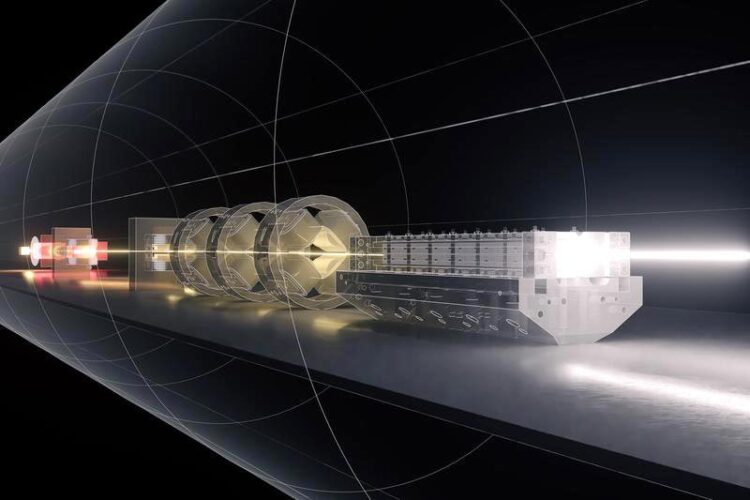Ice-cold electron beams for ultra-compact X-ray lasers

Construction plan of the Plasma-X-FEL.
Credit: University of Strathclyde / Science Communication Lab
Ice-cold electron beams simulated in research at the University of Strathclyde could pave the way to reducing X-ray free-electron lasers (X-FELs) to a fraction of their current size.
X-FELs convert the kinetic energy of an electron beam into powerful photon pulses, down to hard X-ray wavelengths, and are often called ‘engines of discovery.’ X-FELs are used to create extreme matter conditions for hot-dense matter research, to study properties of materials for next-generation microchips, to resolve the structure of complex biomolecules for new medications, and many other applications.
At the heart of FELs are electron beams swinging on a path inside a device, known as an undulator, with an alternating magnetic field. As a result of the wiggling motion, the electron beam emits bursts of photons and a positive feedback effect structures the electron beam into micro-bunches at the radiation wavelength. Consequently, the radiation power grows exponentially along the undulator and becomes highly coherent.
This self-organizing effect can occur only if the electron beam is of high quality at relativistic energies. However, to meet the stringent electron beam quality requirements, state-of-the-art X-FELs are kilometre-scale finely tuned machines, costing as much as a billion-pounds. Consequently, only a handful of X-FEL facilities exist worldwide, with none in the UK so far.
The Strathclyde research shows, with high-fidelity start-to-end simulations, that a Plasma Wakefield Accelerator (PWFA), equipped with a ‘Trojan horse’ advanced electron injection method called plasma photocathode, can produce electron beams 100,000 times brighter than state-of-the-art. This is because of the low momentum spread distribution, producing extremely cold electron beams.
The PWFA also has an accelerating electric field, with a capacity of tens to hundreds of gigavolt-per-meters, which enables the realisation of the accelerator on a centimetre scale, compared with the kilometre scales of traditional accelerators.
The study explores how to extract, transport, isolate and inject the ultra-high brightness, ice-cold electron beams from plasma photocathode PWFA into an undulator without charge and quality loss; they remain cold and do not ‘melt.’ Focused into an undulator, the ultrahigh quality electron beam produces powerful coherent, laser-like photon pulses, with pulse durations in the attosecond regime (1×10−18 of a second). In addition to the extreme quality of the electron and resulting photon pulses, the entire system may have a spatial footprint of only few tens of metres, in contrast to state-of-the-art, kilometre-size X-FEL machines.
The scientists working on the study believe that the three milestones achieved in the study could be a gateway to next-generation ultra-compact X-FELs. The study has been published in the journal Nature Communications and forms part of the nationwide UK X-FEL project.
Fahim Habib, a Research Associate in Strathclyde’s Department of Physics and leading post-doctoral researcher of the study, said: “The prospects of ultra-compact plasma-X-FELs based on this scheme are mind-boggling. Our results are important first milestones, but much more work is ahead of us towards experimental realization of the approach.”
Professor Bernhard Hidding of Strathclyde, who leads the project, said: “The first experimental evidence for plasma photocathode injection in PWFA was obtained in our Trojan Horse collaboration at our strategic partner Stanford’s SLAC FACET facility. Now, with our programme at the successor facility SLAC FACET-II, we aim to exploit the true potential of the scheme in terms of beam quality and stability.”
Dr Brian McNeil, a Reader in the Department of Physics, said: “Brightness is the key performance parameter for free-electron-lasing. If electron beams as bright and short as shown in our computational study can be realized from plasmas, this could have an enormous impact on photon science.”
Professor Hidding works on a parallel project, funded by the European Research Council, named NeXource: Next-generation Plasma-based Electron Beam Sources for High-brightness Photon Science.
Dr McNeil was awarded the international Free-Electron-Laser Prize in 2022, in recognition of his outstanding contribution to the field.
Journal: Nature Communications
DOI: 10.1038/s41467-023-36592-z
Method of Research: Experimental study
Subject of Research: Not applicable
Article Title: Attosecond-Angstrom free-electron-laser towards the cold beam limit
Article Publication Date: 24-Feb-2023
Media Contact
Paul Gallagher
University of Strathclyde
paul.gallagher@strath.ac.uk
Office: 0044-141-548-2370
Cell: 07969 045919
All latest news from the category: Physics and Astronomy
This area deals with the fundamental laws and building blocks of nature and how they interact, the properties and the behavior of matter, and research into space and time and their structures.
innovations-report provides in-depth reports and articles on subjects such as astrophysics, laser technologies, nuclear, quantum, particle and solid-state physics, nanotechnologies, planetary research and findings (Mars, Venus) and developments related to the Hubble Telescope.
Newest articles

New model of neuronal circuit provides insight on eye movement
Working with week-old zebrafish larva, researchers at Weill Cornell Medicine and colleagues decoded how the connections formed by a network of neurons in the brainstem guide the fishes’ gaze. The…

Innovative protocol maps NMDA receptors in Alzheimer’s-Affected brains
Researchers from the Institute for Neurosciences (IN), a joint center of the Miguel Hernández University of Elche (UMH) and the Spanish National Research Council (CSIC), who are also part of…

New insights into sleep
…uncover key mechanisms related to cognitive function. Discovery suggests broad implications for giving brain a boost. While it’s well known that sleep enhances cognitive performance, the underlying neural mechanisms, particularly…



